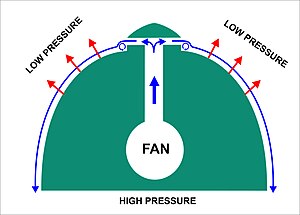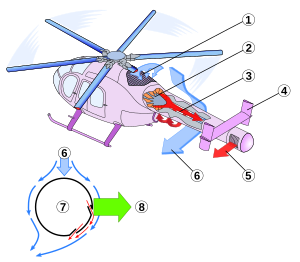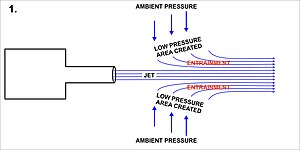Coanda Effect
The Coandă effect is a physical phenomenon in which a flow of fluid—gaseous or liquid—tends to be attracted by a surface neighboring its path. The term was coined by Albert Metral in honor of the Romanian aeronautical engineer Henri Coandă, who discovered the effect in his jet airplane prototype around 1910. It was explicitly documented in two patents published in 1936.
Discovery
A previous description of this phenomenon was provided by Thomas Young in a lecture given at the Royal Society in 1800:
The lateral pressure that pushes the flame of a candle into the air jet of a blow is probably very similar to the pressure that facilitates the inflection of the air current near an obstacle. If you see the hole that creates a thin air current on the surface of the water, by placing a convex object in contact with the side of the current, in the place of the hole you will immediately show that the current is diverted to the object; and if the object is free to move in all directions, it will be driven to the current...
About one hundred years later, the Coandă effect was discovered in 1910 by Henri Coandă (1885-1972), who became interested in the phenomenon after destroying a prototype airplane developed by him (Coandă-1910).
After observing how the flames and burned gases coming out of the engines approached the fuselage, Coandă noticed that a fluid tends to follow the contour of the surface on which it hits, whether the curvature of the same, or the angle of incidence of the fluid with the surface, are not too pronounced.
First approach
A good way to explain what the Coandă effect consists of is with an example: suppose a curved surface, for example a cylinder, as shown in the illustration to the right. If something solid is poured on it (rice, for example) it will bounce back. The cylinder, due to the action-reaction principle, will tend to go to the left, this can be seen in the first part of the illustration. If this experiment is repeated with a liquid, due to its viscosity, it will tend to "stick" to the curved surface. In this case, the fluid will be drawn into the cylinder. If we imagine that the liquid is made up of thousands of layers of water, the layers that touch the cylinder will stick together; The adjacent layers, due to friction, will stick to it and deviate a little; The following layers will also deviate somewhat more.
Mechanism

A jet of air drags molecules from around it, creating a "tube" or "cuff" low pressure around the jet (see Diagram 1). The resulting forces from this low-pressure tube compensate for any unstable perpendicular flow, stabilizing the jet in a straight line. However, if a solid surface is placed nearby parallel to the jet (see Diagram 2), the entrainment of air between the solid surface and the jet causes a reduction in pressure on that side, deflecting the jet in the process (see Diagram 3). With curved surfaces, the jet deflects more (see Diagram 4), because each infinitesimal change in the direction of the surface produces the effects described for the initial bending of the jet towards the surface, increasing the adhesion of the jet.
If the surface is not perfectly curved, the jet, under the right circumstances, can adhere to the surface even after rotating 180° and thus go in the opposite direction to the initial one. The forces that cause these changes in direction generate an equal and opposite force on the surface through which the jet flows. These forces induced by the Coandă effect can be harnessed to generate lift or other types of motion, depending on the orientation of the jet. jet and the surface to which it adheres. If we put a small "lip" where the jet begins (see Diagram 5), a low-pressure vortex is produced behind the lip, increasing the deflection of the jet toward the surface.
The Coandă effect can be induced in any fluid, both liquid and gaseous.
Applications
Aviation
The Coandă effect has applications in various high-lift devices in aviation, where the air above the wing can be "sent" towards the ground thanks to the flaps, so that the air jet runs along the curved surface of the upper part of the wing. Flow bending translates into lift. Flow from a jet engine mounted inside a nacelle on the wing produces an increase in lift by dramatically increasing the velocity gradient of the boundary layer shear flow. In this velocity gradient, some particles escape from the surface as the pressure in that area drops. John Frost of Avro Canada investigated this effect, designing a series of airplanes with certain similarities to hovercraft, in which the air It leaves a ring that surrounds the aircraft and is directed towards another ring that acts as a flap.

These studies culminated in the development of the Avro Canada VZ-9 Avrocar, which was a Canadian vertical take-off and landing (VTOL) aircraft built by Avro Aircraft Ltd. as part of a secret United States military project, which was The Avrocar used the Coandă effect to create lift from a single "turborotor" that blows air to the edge of the aircraft to provide it with VTOL capabilities. In the air, it would have looked very similar to flying saucers. Two prototypes were built as "proof of concept" with the idea of creating a more advanced fighter for the United States Air Force and also as tactical air equipment for the United States Army.
Project 1794, which was the code name designated to the project, aimed to reach speeds of Mach 3 and Mach 4. The documents remained classified until 2012.
The effect was also implemented in the Advanced Medium STOL Transport (AMST) project of the United States Army.
Many aircraft use this effect, most notably the Boeing YC-14 (the first modern aircraft to implement the Coandă effect), NASA's Blown Flap Augmented Wing STOL Research Aircraft, or the Asuka aircraft of the National Aerospace Laboratory of Japan (National Aerospace Laboratory of Japan, NAL). The way to take advantage of the effect is to mount turbofan-type engines on top of the wings to provide them with high-speed air even when flying at low speeds.
However, there is only one aircraft that has entered serial production and takes advantage of this effect, the Antonov An-72 "Coaler". The Shin Meiwa US-1A uses a similar system, redirecting jet from its four propeller engines over the wing to generate low-speed lift. In addition, it incorporates a fifth engine within the center section of the wing to provide air to the blown flaps. These two systems, together, provide this aircraft with great capabilities in short takeoffs and landings (STOL).



The experimental McDonnell Douglas YC-15 aircraft and its production version, the Boeing C-17 Globemaster III, also use the same effect. NOTAR type helicopters replace the conventional tail rotor with a Coandă effect tail (diagram on the left).
Air conditioning
In air conditioning systems, the Coandă effect serves to increase the jet in ceiling-mounted systems. As the Coandă effect causes the air leaving the diffuser to "stick" to the ceiling, the air reaches further. This means that the speed of the fans can be lower, which reduces noise and, in the case of variable air volume (VAV) systems, higher turndown ratios. Diffusers that have a longer contact length with the ceiling experience a greater Coandă effect.
Medical care
In cardiology, the Coandă effect is responsible for separating blood in the right atrium of the fetus. It also explains why the eccentric flows produced in mitral regurgitation are attracted and dispersed along the surfaces of the left atrial wall adjacent (can be seen as 'wall-hugging' flows on echocardiograms). This is clinically relevant because the visual area (and therefore severity) of these "embracing" the wall are usually underestimated compared to the central flows, which are easier to appreciate. In these cases, it is preferable to use volumetric methods to quantify the severity of mitral regurgitation.
The Coandă effect is also used in assisted ventilation devices.
Meteorology
In meteorology, the theory of the Coandă effect has been applied to some wind currents that cross mountain ranges such as the Carpathian Mountains and the Transylvanian Alps, where its effects on agriculture and vegetation have been demonstrated. It also has influence in the Rhône Valley in France and near the Big Delta in Alaska.
Motor racing
In Formula 1, the Coandă effect has been used by several teams such as McLaren, Sauber, Ferrari and Lotus, after it was introduced by Adrian Newey (Red Bull Racing) in 2011, helping to redirect exhaust gases to through the rear diffuser with the intention of creating greater ground effect at the rear of the car.
Due to a change in regulations made by the FIA at the beginning of the 2014 Formula 1 season, this practice was prohibited by introducing a new rule by which the exhaust pipe must not have any part of the bodywork around it. with the intention of creating some aerodynamic effect.
Other uses
In fluid logic, the Coandă effect has been used to create bistable multivibrators, where the working flow (compressed air) was attached to a curved wall and control beams could change the flow between the walls.
Likewise, the Coandă effect is also used to mix two fluids.
Contenido relacionado
Nanosecond
Hawking radiation
Reradiation







